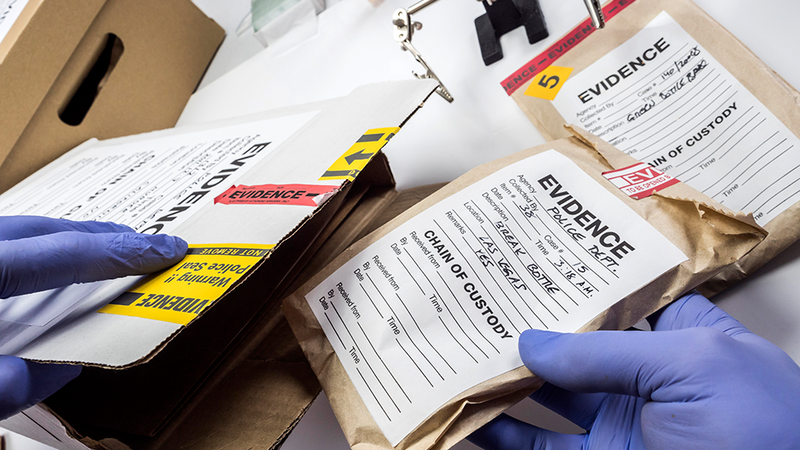Every investigation, whether criminal or corporate, relies on a secure chain of custody to maintain the integrity of its evidence. However, evidence could be easily compromised without proper tools and protocols.
In this guide, we’ll discuss the key tools and steps needed to manage evidence, from collection to courtroom presentation. Understanding and applying these principles is critical for anyone involved in evidence handling to ensure fair and reliable outcomes.
Understanding the Chain of Custody
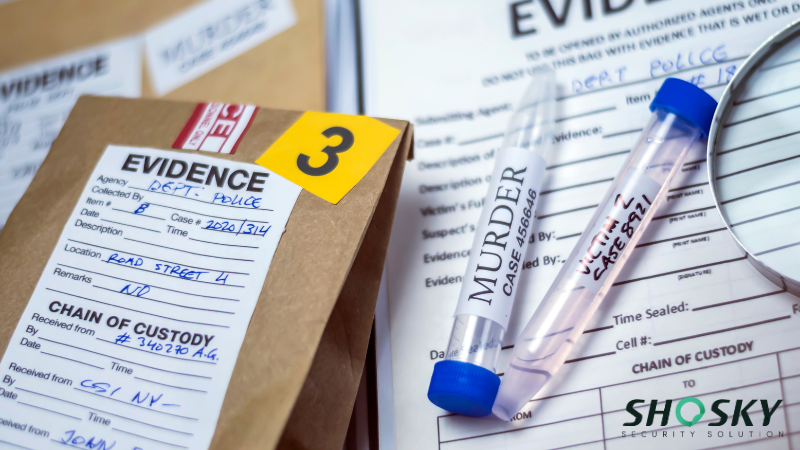
Before diving into the tools that support secure evidence handling, it’s important to define what chain of custody means and why it matters across legal, forensic, and corporate settings.
What is Chain of Custody?
The chain of custody is a detailed, chronological documentation of the handling, transfer, and storage of evidence from the moment it’s collected to its presentation in court or other formal setting. Its primary purpose is to safeguard evidence integrity in a scrupulously careful manner and establish an unbroken record of its handling.
The chain of custody is the backbone of evidence management. It is a concept that is universally recognized in various industries, including criminal investigations, corporate audits, and medical malpractice cases.
Why is Chain of Custody Critical?
The chain of custody is necessary in safeguarding the integrity of records and ensuring justice in cases involving a defendant accused of a crime. Without a well-documented and secure process, electronic evidence or physical items at an alleged crime scene risk being challenged in court, undermining their credibility and the case built upon them.
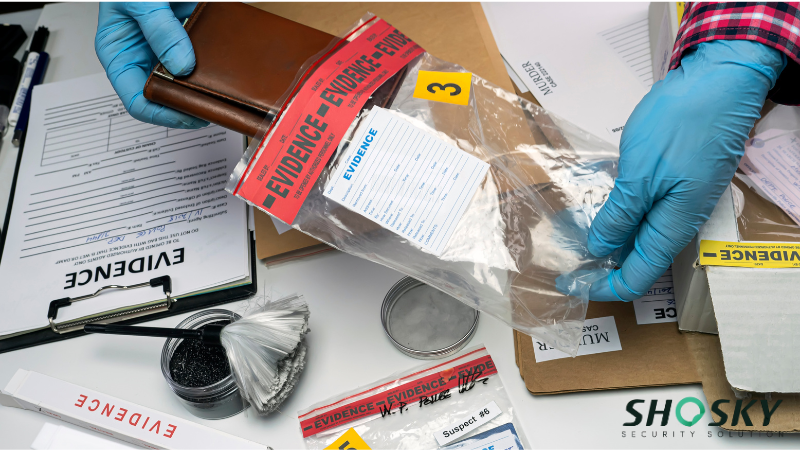
Maintaining an unbroken chain of custody, on the other hand, ensures that every piece of evidence remains authentic, untampered, and admissible, enabling the evidence clerk or police officers to present evidence effectively in court.
Moreover, adherence to custody documentation and chain-of-custody protocols reduces the risk of legal disputes. Cases involving mishandled evidence often led to lengthy appeals, mistrials, or acquittals due to reasonable doubt.
Tamper-Evident Solutions for Chain of Custody
When it comes to maintaining an unbroken chain of custody, a variety of tamper-evident tools are available. Here are a few of the essential ones:
Tamper-Evident Bags
Ensuring evidence security starts with reliable tamper-evident bags. Tamper-evident bags are storage solutions designed to provide visual evidence of unauthorized access or tampering.
Their primary function is to ensure the integrity and security of their contents, offering a clear indication if someone has attempted to open or compromise the package. This is crucial in such cases where custody issues can arise, and maintaining the integrity of the contents is paramount.
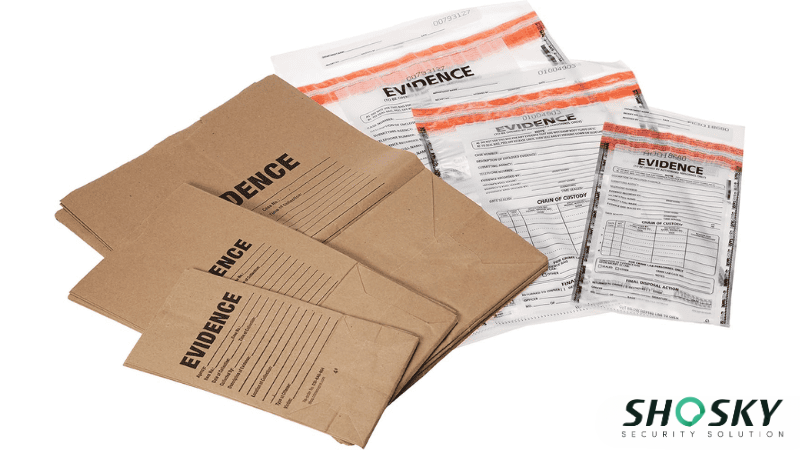
The most common types of tamper-evident bags include plastic tamper-evident bags, paper tamper-evident bags, and reusable tamper-evident bags:
- Plastic Tamper-Evident Bags: These are the most commonly used type and are made from durable plastic materials. They often feature heat-sealed seams, which are designed to break if tampered with, providing records of any unauthorized access.
- Paper Tamper-Evident Bags: These bags are used when evidence needs to be sealed in a more environmentally friendly or discreet manner. Paper bags often have adhesive seals that show clear signs of tampering.
- Reusable Tamper-Evident Bags: These bags can be used multiple times without compromising the security of the collected items. They are made from heavy-duty materials and feature specialized sealing mechanisms that ensure the bag can be resealed after use without risk of contamination.
Tamper-evident bags are equipped with several key features to ensure evidence security. These bags include different security seal types, such as adhesive seals, zipper closures, and heat seals, that break when tampered with, providing clear signs of unauthorized access.
Many bags also feature unique serial numbers for tracking purposes, ensuring each piece of record can be individually identified and linked to a specific case. Additionally, the bags are made from tear-resistant materials, which makes them harder to open without leaving visible evidence of tampering, thus further securing the contents inside.
This attention to detail is crucial in proving the identity and legitimacy of the evidence in court.
Tamper-Evident Bag Tape

While tamper-evident bags are essential for protecting evidence, ensuring the bags are properly documented with accurate tamper-evident bag tape is equally important. Tamper-evident bag tapes contain vital information about the case, evidence, and individuals involved in the collection process.
Proper labeling ensures accountability, minimizes the risk of errors, and provides a clear timeline of the evidence’s journey from collection to court.
The information that should be included on a tamper-evident bag tape includes:
- Case ID: This unique identifier ties the evidence to a specific case, ensuring that the evidence can be matched with its corresponding case file.
- Collector’s Name: The name or identity of the person involved in evidence gathering must be included to maintain accountability and prevent disputes about who handled the evidence.
- Date and Time: Documenting the exact date and time of collection is critical for maintaining an accurate timeline of the evidence’s handling.
The placement of the label on the evidence bag is just as significant as the information it contains. Labels should be adhered securely in a visible location that does not interfere with the bag’s tampering seals. This placement ensures the label remains intact throughout the chain of custody, even when stored in a secure place or under controlled security conditions.
Comprehensive labeling plays a crucial role in the investigation process. It helps prevent tampering, avoids errors, and ensures the evidence’s journey is properly documented from initial possession to court testimony. By enabling investigators, lawyers, and the jury to track evidence effectively, accurate labeling supports the efforts to convict persons and uphold justice.
Tamper-Evident Tape

Tamper-evident security tape is an essential tool for sealing packages, evidence boxes, and storage containers. Its main purpose is to reveal any attempt to tamper with a sealed item. When someone tries to lift or peel the tape, it leaves visible signs. These may include a hidden message like “VOID” or “OPENED,” damage to the surface, or a color change. These features serve as a visual warning.
Security tape strengthens the protection of bags, envelopes, cartons, and similar items. Once applied, it bonds firmly to the surface. It cannot be removed or repositioned without showing signs of interference. This is critical when transporting or storing sensitive materials or high-value goods.
Common features of security tape include:
- Tamper-Reveal Messages: Words or symbols appear if the tape is disturbed.
- Sequential Numbering: Matches sealed items to their records.
- Custom Printing: Barcodes, logos, or case IDs can be printed in advance.
- Material Options: Available in destructible vinyl, film, or paper for different applications.
Security tape is often used on document pouches, evidence containers, and equipment panels. It helps verify authenticity during inspections. It also works well with other tamper-evident tools, such as bag seals or RFID tags.
Tamper-Evident Seals
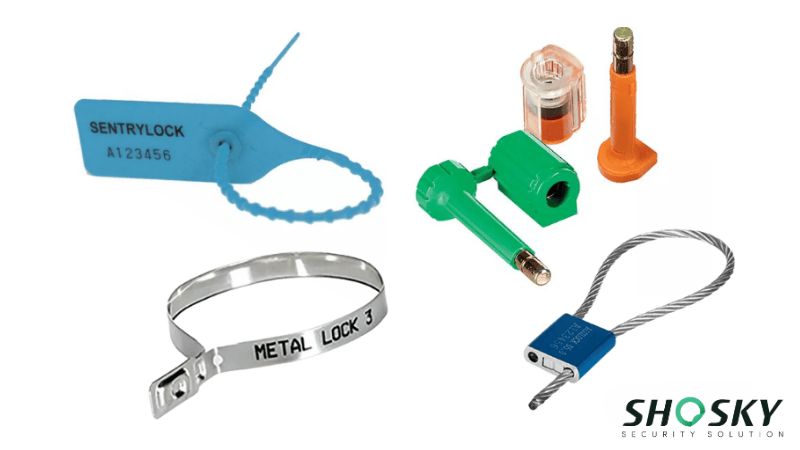
Security seals are locking devices that protect containers, doors, cabinets, or bags from unauthorized access. Once applied, these seals must be broken or damaged to open the item.
Each type of seal is designed for specific levels of security:
- Plastic Pull-Tight Seals: Adjustable and disposable. Ideal for bags and totes.
- Bolt and Cable Seals: Strong and tamper-resistant. Used on freight and shipping containers.
- Metal Strap Seals: More durable than plastic. Used when extra strength is needed.
- Twist or Wire Seals: Common in meter reading and law enforcement.
Security seals often include the following features:
- Unique Serial Numbers: Prevent replacement and support inventory tracking.
- Barcodes or QR Codes: Allow digital scanning and monitoring.
- Color-Coding: Helps with sorting and identification.
In chain-of-custody processes, security seals act as control points. They show whether an item was accessed between transfers. Their low cost, simplicity, and visibility make them a reliable choice across industries like law enforcement, logistics, retail, and legal services.
Other Tools and Technologies for the chain of custody
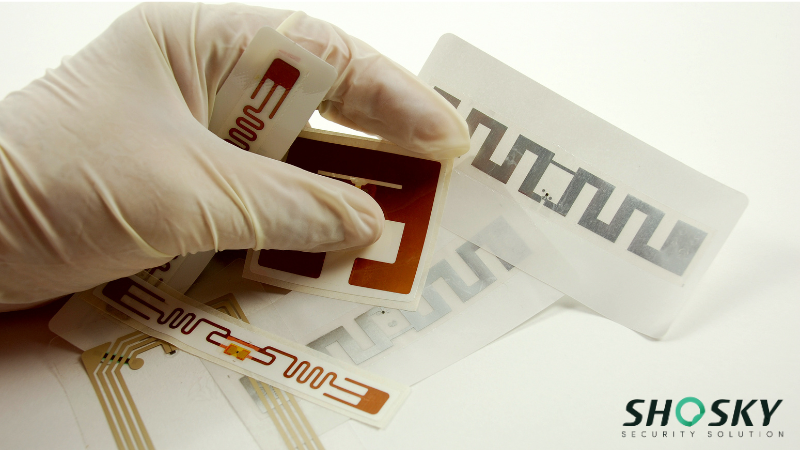
In addition to tamper-evident solutions, there are several other tools and technologies available to support chain of custody issues.
RFID Technology
Radio Frequency Identification (RFID) provides wireless tracking of items using digital tags. Each tag has a unique identifier. These tags are often placed inside tamper-evident bags or secured storage containers. RFID technology offers real-time updates on item location. It reduces the need for manual handling and increases accuracy.
RFID systems also create automatic records. Every scan or interaction is logged. This helps maintain transparency and ensures full accountability. Organizations use RFID to manage large amounts of evidence or materials. It improves search times, reduces human error, and supports efficient workflows.
Chain-of-Custody Forms
For the prosecution in criminal cases, having a fully completed and accurate chain of custody form is crucial to address any legal challenges regarding the authenticity of the evidence. Chain-of-custody forms are used to document every interaction with the evidence, from collection through to courtroom presentation.
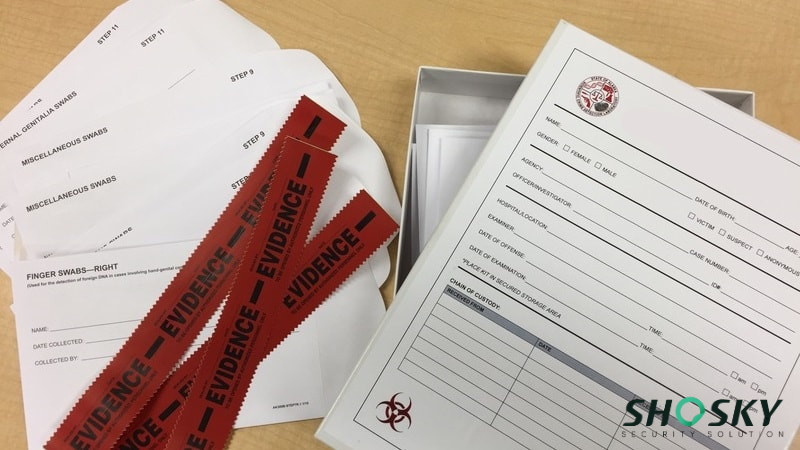
These forms provide a written record of the evidence’s journey, which is crucial for ensuring transparency and accountability. They typically include sections for the collector’s name, date, time, storage location, and the signature of each individual who handles the evidence.
Digital Evidence Tracking Systems
Modern investigations often involve digital evidence or electronic evidence, which requires advanced tracking systems. Digital evidence tracking systems automate many of the manual processes involved in the chain of custody, offering real-time updates on the status and location of evidence.
These systems are increasingly used in place of paper-based systems, providing greater efficiency, security, and accessibility for law enforcement agencies.
Step-by-Step Guide to Maintain Chain of Custody
As we discussed above, maintaining an unbroken chain of custody is essential to ensure the integrity and admissibility of evidence in legal proceedings. Now, here is a step-by-step guide to maintaining the chain of custody throughout the evidence-handling process.
Step 1: Evidence Collection
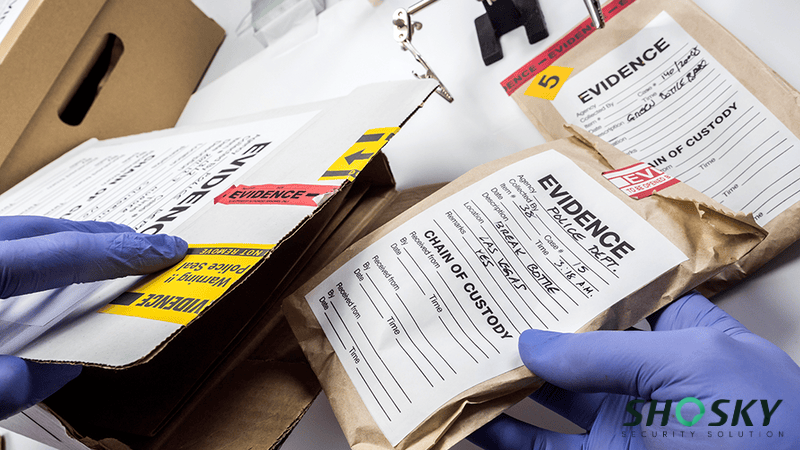
The foundation of a strong chain of custody begins at the point of evidence collection. Proper handling techniques are essential to avoid contamination or alteration of the evidence. Investigators must use appropriate tools and follow established protocols to gather and package each item securely.
When collecting evidence, it should be placed immediately into tamper-evident bags. These specialized containers visibly indicate any unauthorized access, providing a clear record of the evidence’s integrity. Accurately completing the evidence bag labels is also crucial at this stage, documenting the case details, the collector’s name, date, and time of collection.
Step 2: Evidence Storage
After collection, the evidence must be stored in a secure location that maintains its integrity. Choosing the appropriate storage facility is key, with considerations given to factors like access control, environmental conditions, and monitoring systems. Restricted-access evidence rooms or specialized storage containers can help prevent unauthorized entry and ensure the continued safety of the evidence.
Establishing clear access protocols and maintaining detailed logs of everyone who interacts with the evidence are essential. Periodic audits and inspections of the storage area further reinforce the chain of custody by verifying the continued integrity of the evidence.
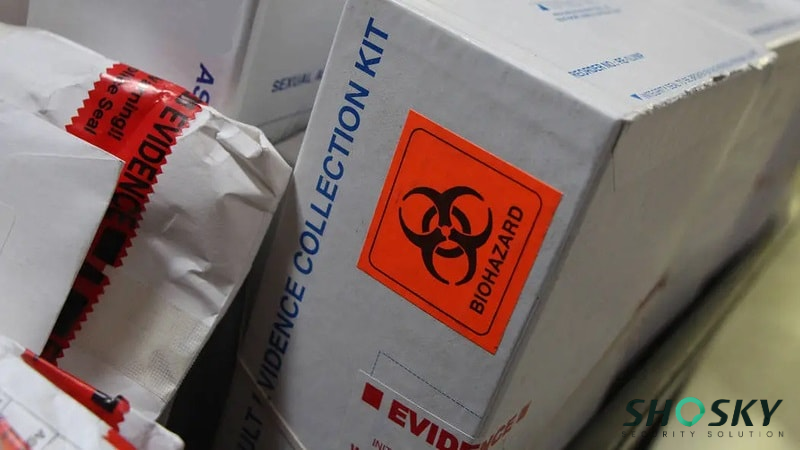
Step 3: Evidence Transfer
When the evidence needs to be moved between locations or handed off to different parties, such as law enforcement, forensic teams, or legal professionals, the chain of custody must be carefully documented.
Standardized protocols for evidence transfer should be followed, including the use of tamper-evident seals on transportation containers and the completion of comprehensive chain-of-custody forms.
The chain-of-custody forms provide a detailed record of the evidence’s journey, including the names of individuals involved, the dates and times of each transfer, and the reasons for the movement. This documentation ensures a clear and unbroken trail of custody, minimizing the risk of evidence tampering or mishandling.
Step 4: Court Presentation or Final Disposition
When the time comes to present the evidence in court or dispose of it after the case’s conclusion, the chain of custody must be maintained until the very end.
Investigators must demonstrate that the evidence has remained intact and unaltered throughout the entire process, from collection to the courtroom or final disposition.

During court presentations, the handling history and documentation of the chain of custody will be scrutinized. That’s why meticulous record-keeping and the ability to account for every step of the evidence’s journey are essential to upholding its credibility and admissibility.
After the case is closed, the final documentation, including the resolution of the chain of custody, must be carefully recorded and preserved for potential future reference or legal proceedings.
Legal Implications of Chain of Custody Breaches
The consequences of breaches in the chain of custody can be severe, with the potential to impact the outcome of legal proceedings and erode public trust in the judicial system. High-profile cases, such as the O.J. Simpson trial and the Rodney King case, have demonstrated how mishandling of evidence can lead to acquittals or case dismissals, undermining the pursuit of justice.
In the O.J. Simpson trial, evidence tampering and mishandling were key points raised by the defense, leading to doubts about the integrity of the chain of custody. Similarly, in the Rodney King case, discrepancies in the handling and presentation of evidence played a significant role in questioning the credibility of the prosecution’s case.

These high-profile examples highlight the critical importance of maintaining a secure and accurate chain of custody in legal proceedings. In addition to the immediate impact on specific cases, breaches in the chain of custody can also result in legal penalties for those responsible, including fines or criminal charges for tampering or negligence.
More broadly, such breaches can compromise the credibility of forensic evidence, undermining the overall effectiveness of investigative and prosecutorial efforts.
Common Mistakes to Avoid in Chain of Custody
To maintain a robust chain of custody, it is essential to avoid common pitfalls that can compromise the integrity of evidence. These include:
- Improper sealing or labeling of the evidence bag
- Failing to document every step of the evidence transfer process
- Using low-quality or generic bags that compromise security
- Ignoring storage protocols leads to evidence of contamination
By adhering to established protocols, training personnel, and fostering collaboration across teams, organizations can safeguard the chain of custody and ensure the reliability and admissibility of evidence in legal proceedings and other formal settings.
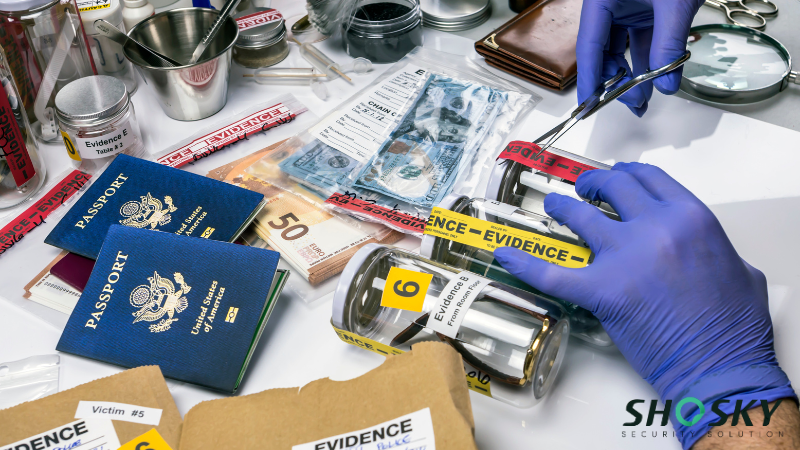
FAQs
What is the correct order for the chain of custody?
The correct order for the chain of custody involves evidence collection, evidence storage, evidence transfer, and court presentation (with full documentation).
Are digital chain-of-custody systems reliable for court use?
Yes, digital chain-of-custody systems are reliable for court use as long as they are properly implemented and maintain full audit trails.
What is an example of a broken chain of custody?
A broken chain of custody occurs if evidence is mishandled or improperly documented, such as an investigator failing to properly seal a tamper-evident bag or failing to record the transfer of evidence.
Conclusion
A well-managed chain of custody is critical to maintaining the integrity of evidence in legal proceedings. The use of bags, labels, RFID tags, and other security tools provides transparency, efficiency, and accountability throughout the evidence-handling process to manage a secure chain of custody. By implementing robust security solutions, you ensure that evidence remains protected and trusted from collection to presentation in court.
Maintain a Foolproof Chain of Custody
To ensure your evidence management system is foolproof, consider Shosky Security’s range of tamper-evident solutions. Our products help you safeguard the integrity of your evidence throughout its journey. Contact us to learn more about our customized security solutions and protect your evidence with the highest level of reliability and transparency!
